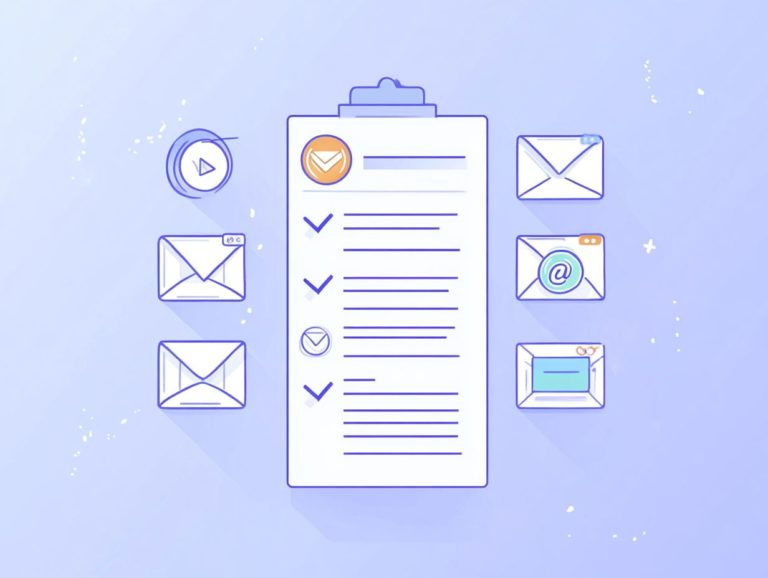How to Use Analytics to Improve Emails
Let's Set Up Your Lead Generation Strategy
Fill out the form below, and our team will get in touch with you to create a tailored solution for your business.
In today’s digital landscape, email marketing stands as a formidable instrument for businesses to forge connections with their audience. However, merely dispatching emails won’t cut it; understanding how your emails perform is crucial.
This discussion delves into the vital role of email analytics in email marketing. We’ll spotlight key metrics like open rates, click-through rates, and conversion rates. You’ll discover how to leverage these insights to refine your content, segment your email list effectively, conduct A/B testing (comparing two versions of an email to see which performs better), and enhance email deliverability.
This will help your email campaigns reach their full potential.
Contents
- Key Takeaways:
- The Importance of Analytics for Email Marketing
- Key Metrics to Track
- Let's Set Up Your Lead Generation Strategy
- Using Analytics to Optimize Email Content
- Let's Set Up Your Lead Generation Strategy
- Segmenting Your Email List for Better Analytics
- Let's Set Up Your Lead Generation Strategy
- Leveraging A/B Testing for Email Optimization
- Let's Set Up Your Lead Generation Strategy
- Utilizing Analytics to Improve Email Deliverability
- Frequently Asked Questions
- Why should you care about analytics in email marketing?
- How do I track the performance of my emails using analytics?
- What are some key metrics to look at when analyzing email performance?
- How can I use analytics to improve the content of my emails?
- How can I use analytics to improve the timing of my emails?
- Let's Set Up Your Lead Generation Strategy
Key Takeaways:

- Use analytics to track key metrics such as open rates, click-through rates, and conversion rates for email performance.
- Optimize email content by identifying top-performing content and adjusting it based on analytics.
- Improve email deliverability by identifying and addressing issues and following best practices.
The Importance of Analytics for Email Marketing
In today’s fast-paced digital landscape, understanding the significance of analytics for email marketing is essential for any business aiming to elevate customer engagement and maximize return on investment.
Email analytics offer crucial insights into key performance indicators such as open rates, click-through rates, and conversion rates. This gives you the power to make data-driven decisions that can substantially enhance your email performance and overall campaign performance.
Unlock these metrics to supercharge your email strategies, tailor your approach to your audience’s preferences, and ultimately boost email engagement and sales through meticulously targeted email campaigns.
Why Analytics Matter for Email Performance
Analytics are essential for monitoring email performance, including tracking spam rates and unsubscribe rates. They allow you to assess key metrics like open rates and click-through rates, which are crucial for evaluating the effectiveness of your email campaigns.
These metrics act as vital indicators, giving you insight into how well your emails resonate with your target audience. Don’t overlook your spam rates they can make or break your campaigns! Elevated levels can indicate a disconnect between your content and audience expectations. By identifying these issues, you can fine-tune your marketing strategies to boost overall engagement metrics.
The systematic collection and analysis of this data empower you to refine your messaging, tailor your content, and ultimately build stronger relationships with your subscribers through better email engagement. This approach leads to improved conversion rates and enhanced customer loyalty through effective email marketing.
Key Metrics to Track
Tracking key metrics in email marketing is essential for grasping campaign performance and fine-tuning future strategies.
Metrics like open rates, click-through rates, conversion rates, bounce rates, and delivery rates offer invaluable insights into how effectively your emails connect with recipients and the overall success of your email marketing efforts.
By diving into these metrics, you can assess engagement levels, pinpoint areas that need improvement, and refine your email marketing strategies with actionable insights.
Implement these strategies today to elevate your email marketing efforts!
Open Rates
Open rates are a pivotal metric in your email marketing strategy, reflecting the percentage of recipients who open your emails. They offer valuable insights into the effectiveness of your subject lines and overall email engagement metrics.
Let's Set Up Your Lead Generation Strategy
Fill out the form below, and our team will get in touch with you to create a tailored solution for your business.
It’s essential for you to understand what influences these rates. Timing is a key factor; for example, emails dispatched on weekdays typically achieve higher read rates than those sent on weekends. Crafting an eye-catching subject line is crucial, as it can entice recipients to click. Create captivating titles that grab attention! It’s crucial for your success!
Implementing strategies like testing different email options will enable you to discover which subject lines perform best. This allows you to fine-tune your email strategy.
Incorporating personalization techniques, like using the recipient’s name, can significantly increase open rates.
Click-Through Rates
Click-through rates (CTR) reveal the percentage of recipients who engage with links in your emails. This serves as a vital gauge of engagement metrics and interest in the content you provide.
This metric is key in assessing the overall effectiveness of your email marketing efforts. Elevated CTRs often align with improved conversion rates, indicating that when your recipients are motivated to interact with the email, it shows a positive reception.
To optimize CTR, focus on strategies like incorporating clear calls-to-action that direct recipients on their next steps. Additionally, using compelling visuals that capture their attention can significantly enhance your click rates. For instance, using well-designed buttons instead of plain text links can make a dramatic difference!
Conversion Rates

Conversion rates reflect the percentage of your email recipients who take a desired action, such as making a purchase or signing up for a newsletter. This metric is vital for evaluating the overall success of your email marketing campaigns.
To enhance conversion rates, consider other key performance indicators like click-through rates (CTR). A higher CTR often suggests improved conversion rates, indicating that when recipients are enticed to click, they are more likely to follow through on those desired actions.
Develop targeted offers that resonate with specific audience segments. Optimizing landing pages to ensure a user-friendly experience aligned with your email’s messaging is crucial. When potential customers encounter a seamless browsing experience, they are far more inclined to act, ultimately driving your conversion rate even higher!
Using Analytics to Optimize Email Content
Utilizing analytics to optimize your email content is vital for maximizing engagement and elevating your campaign outcomes.
By diving into performance data, you can uncover actionable insights that reveal what truly resonates with your target audience. Identifying top-performing content allows you to refine and adjust your future emails based on these valuable findings.
This data-driven approach not only enhances customer engagement but also significantly boosts the return on investment for your email marketing efforts.
Identifying Top Performing Content
Identifying your top-performing content through email analytics gives you the power to grasp which messages truly resonate with your audience and the reasons behind that connection.
To achieve this level of insight, it’s crucial to analyze various metrics. Open rates are vital indicators of how well your subject lines work. Click-through rates show how engaging and relevant your content is once the email is opened.
Let's Set Up Your Lead Generation Strategy
Fill out the form below, and our team will get in touch with you to create a tailored solution for your business.
By comparing these metrics across different campaigns, you can uncover patterns that drive higher engagement and adjust your strategies accordingly. Segmenting data by demographics or consumer behavior further enhances your analysis, illuminating specific audience preferences.
This enables you to tailor future campaigns for maximum impact using detailed marketing analytics.
Adjusting Content Based on Analytics
Adjusting your email content based on analytics means leveraging performance metrics to refine your messaging, design, and calls-to-action in future campaigns.
By closely examining open rates, click-through rates, and conversion data, you can uncover valuable insights into what truly resonates with your audience. For example, if a certain subject line resulted in higher engagement, that becomes your go-to template for future headlines.
You can also analyze which images or layouts drive more clicks to inform design choices that captivate your subscribers. Successful brands often utilize A/B testing, which compares two versions to see which performs better.
You might find that a more personalized greeting significantly boosts interaction. These adjustments not only enhance the immediate performance of your emails but also help foster a deeper connection with recipients.
This ultimately leads to improved conversion rates and customer loyalty through enhanced email engagement.
Segmenting Your Email List for Better Analytics
Segmenting your email list is a strategic move that elevates your analytics, enabling you to tailor content and campaigns for specific audience segments.
This not only boosts overall email engagement but also enhances the effectiveness of your efforts in achieving better list growth rates.
By employing this method, you gain a deeper understanding of diverse audience behaviors. This allows you to optimize your marketing strategies to meet varied preferences.
As you track the performance of your segmented campaigns, you’ll uncover invaluable insights that can lead to higher list growth rates and a significantly improved return on investment.
Benefits of Segmenting
Segmenting your email lists unlocks incredible benefits, leading to improved engagement, higher conversion rates, and more personalized customer experiences.
By tailoring your messages to specific demographics or behaviors, you can craft campaigns that resonate deeply with different audiences.
For instance, imagine a clothing retailer segmenting their list by age groups; they might promote trendy styles to younger customers while offering classic pieces to an older crowd.
This targeted approach not only enhances relevance but also fosters a genuine connection with your audience. Consider the example of an online bookstore that segmented its audience based on past purchases and recommended books accordingly.
Let's Set Up Your Lead Generation Strategy
Fill out the form below, and our team will get in touch with you to create a tailored solution for your business.
This strategy resulted in a remarkable boost in open rates and sales. By implementing such approaches, you ensure that your recipients feel valued, ultimately driving brand loyalty and creating lasting relationships.
How to Segment Your List

Segmenting your email list means using criteria like demographics, purchasing behavior, and engagement levels. This helps you craft tailored email campaigns that resonate with specific audience segments.
This approach gives you the power to deliver relevant content. It significantly enhances open rates and engagement. To get started, identify key factors for segmentation, such as age, location, or past purchase history.
Numerous email marketing platforms provide intuitive tools for this task. They allow you to filter your contact lists effortlessly. For example, Mailchimp offers advanced segmentation features that let you combine multiple criteria. Meanwhile, Constant Contact simplifies the process with options based on engagement metrics.
Regularly analyzing your segments keeps your lists fresh and effective. This leads to more successful email campaigns tailored to each audience’s unique preferences.
Leveraging A/B Testing for Email Optimization
Leveraging A/B testing for email optimization is an exceptional strategy. It gives you the power to refine your email marketing metrics. By comparing two variations of an email, you can uncover which one excels in engagement and conversion rates.
This data-driven approach yields actionable insights. It allows you to optimize crucial elements like subject lines, content layout, and calls-to-action. As a result, you enhance the overall effectiveness of your emails and maximize your ROI.
What is A/B Testing?
A/B testing, often referred to as split testing, is a powerful method in email marketing. It involves sending two versions of an email to different segments of your audience. This approach determines which version achieves superior conversion metrics.
This technique is essential for optimizing your campaigns. It gives you the power to experiment with various elements, such as subject lines, messaging, and call-to-action buttons. Analyzing which version resonates more with your subscribers helps you make informed, data-driven decisions that enhance engagement and drive sales.
Here s how the process unfolds:
- Identify a clear goal.
- Segment your audience thoughtfully.
- Craft two distinct email variations.
- Send them out simultaneously.
Once the emails are distributed, it’s crucial to dive into the results. Focus on key performance indicators like open rates and click-through rates. This analysis reveals effective strategies and establishes a foundation for continuous improvement in your future campaigns.
How to Conduct A/B Testing for Emails
Conducting A/B testing for your emails begins with selecting specific elements to evaluate. Segment your audience and analyze the performance of each version to extract actionable insights that will enhance your future marketing strategies.
To kick off a successful A/B test, pinpoint which components of your emails could significantly influence recipient engagement. Think about subject lines, call-to-action buttons, or images. By isolating these variables, you can create two distinct versions of an email. Audience segmentation is key; tailoring the test to specific demographics ensures that the insights you gather are relevant and applicable.
After sending the test emails, utilize robust tools like HubSpot and GetResponse to streamline your data collection and analysis. These tools provide metrics that reveal how different segments interacted with your emails, helping you make informed decisions for your future campaigns.
Let's Set Up Your Lead Generation Strategy
Fill out the form below, and our team will get in touch with you to create a tailored solution for your business.
Utilizing Analytics to Improve Email Deliverability
Using analytics to ensure your emails reach the right people is essential. It effectively minimizes issues related to spam and bounce rates.
By analyzing metrics like hard bounces and soft bounces, you can pinpoint deliverability challenges. Hard bounces are emails that cannot be delivered due to an invalid address. Soft bounces are temporary issues, like a full inbox. Implement strategies to boost inbox placement rates. Consistently monitoring these factors allows you to optimize your email marketing efforts and cultivate stronger customer engagement.
Mastering these strategies will elevate your email marketing game, keeping you ahead of the competition.
Identifying and Addressing Deliverability Issues
Identifying and addressing deliverability issues is crucial for maximizing the effectiveness of your email marketing campaigns. This ensures your emails consistently land in the inbox instead of being relegated to the spam folder.
When your campaign experiences high bounce rates (the percentage of emails that could not be delivered) or is frequently flagged as spam, it can tarnish your reputation and diminish your return on investment. Adopting best practices is essential for success! Regularly update your email lists to remove inactive subscribers and employ double opt-in methods to confirm engagement.
Analyzing your email analytics is equally important. Understanding open rates, click-through rates, and unsubscribe trends can reveal patterns that indicate potential problems. By refining your strategies based on these insights, you can significantly enhance your deliverability and craft more successful campaigns.
Best Practices for Email Deliverability

Implementing best practices for email deliverability is essential for ensuring that your marketing emails land successfully in recipients’ inboxes, which significantly enhances your overall email marketing effectiveness.
To achieve this, focus on maintaining a positive sender reputation, as it’s crucial for steering clear of the spam folder. Utilizing authentication methods like SPF (Sender Policy Framework) and DKIM (DomainKeys Identified Mail) validates the origin of your emails, adding an extra layer of security to the delivery process.
Act now by cleaning your email lists regularly to boost engagement! This not only enhances engagement rates but also improves your overall deliverability. By tracking relevant metrics such as open rates, click-through rates, and bounce rates, you gain vital insights that enable you to fine-tune your strategies and enhance your communication efforts effectively.
Frequently Asked Questions
Why should you care about analytics in email marketing?
Analytics refers to the process of collecting, analyzing, and interpreting data to gain insights and make informed decisions. In email marketing, analytics can help you track the performance of your emails, understand your audience, and improve your overall email strategy.
How do I track the performance of my emails using analytics?
Most email marketing platforms have built-in analytics tools that allow you to track various metrics such as open rates, click-through rates, bounce rates, and conversions. These metrics help you measure the success of your email campaigns and identify areas for improvement.
What are some key metrics to look at when analyzing email performance?
Important metrics to track include open rates, click-through rates, bounce rates, and conversion rates. You may also want to consider metrics such as email deliverability, unsubscribe rates, and email sharing and forwarding rates.
How can I use analytics to improve the content of my emails?
By analyzing data such as open and click-through rates, you gain insights on what types of content your audience is most interested in. Use this information to create more personalized and relevant email content that resonates with your subscribers.
How can I use analytics to improve the timing of my emails?
Analytics can help you determine the best time and day to send your emails for maximum engagement. By examining open and click-through rates at different times and days, you can identify patterns and optimize your email schedule accordingly.
Let's Set Up Your Lead Generation Strategy
Fill out the form below, and our team will get in touch with you to create a tailored solution for your business.
How can I use analytics to segment my email list?
Leverage analytics to gather data on your subscribers such as demographics, interests, and behavior. Use this information to segment your email list into targeted groups and send more personalized and relevant emails to each segment.






